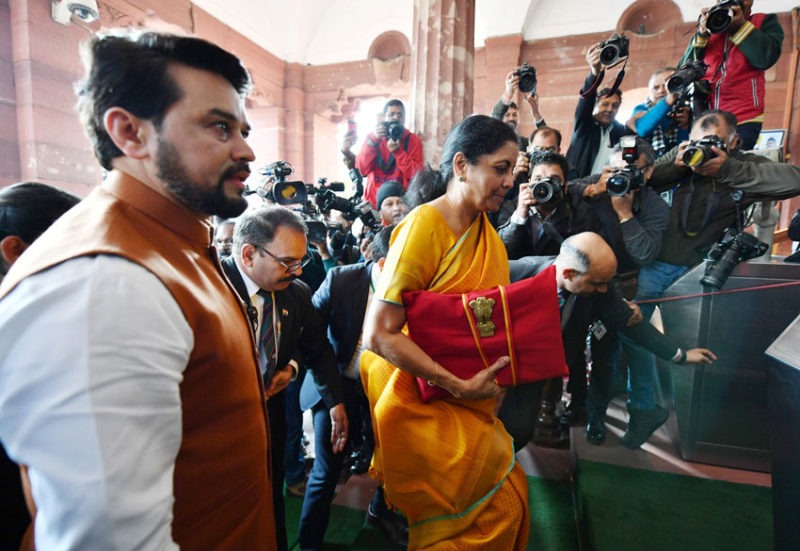Union Budget of India 2020-21: An Enshrinement of a Reformist, Modest Agenda
(Above): India’s Minister for Finance and Corporate Affairs Nirmala Sitharaman arrives at Parliament House to present the General Budget 2020-21, in New Delhi, Feb. 1. The Minister of State for Finance and Corporate Affairs, Anurag Singh Thakur (l) is also seen. (PIB)
In times of a decelerating economy it is but natural for all eyes to be set on Union Budget 2020-2021, writes Priyanka Bhardwaj.
In a marked departure from the big bang declarations of the past, and quite in line with the those tabled during the Narendra Modi era, the 6.0 Modi Budget, worth $428 billion, was a lackluster affair, at best a modest presentation or at worst an insipid one.
The Union Finance Minister Nirmala Sitharaman’s declaration laid out its intent, “to address aims and aspirations – to boost the income and purchasing power”.
Reiterating, “The fundamentals of the economy are strong and that inflation has been well contained. And we have added 60 lakh new taxpayers, in Good & Services Tax (GST) ambit.” Sitharaman, however, cut short before the final two pages of the magnum opus document.
For an economy to drop from 6.8% in 2018 to 4.8% in a single year (source International Monetary Fund) and one which reads high inflation, lowering productivity in key labour industries, a 42 year high unemployment rate (rising to 7% in the third quarter of 2019, Center for Monitoring Indian Economy), weakening financial institutions, high profile bank failures, unsettled trade affairs with the mighty U.S. economy, and an elevated though sustained level of oil prices, for a 1.3 billion plus citizens, majority of whom are temporarily employed in informal and farming areas, and now being forced to forsake the already impoverished standard of Rs.5 (equaling $0.007) a packet of Parle G biscuits for cheaper snacks, there were anticipations galore.
So has the government that has taken months to acknowledge evidence of the economic slump and now would have us believe its theory that the transitory phase to a sustained recovery must be a difficult terrain to cover, run short in its intended aims, by eschewing any “aggression” in kick-starting the economy, through cuts in GST and long term capital gains cuts, a far cry from 2016 when the government had unleashed the purging of the economy with its Benami Transactions (Abolition) Act, Voluntary Disclosure of Income Scheme, Demonetization, Real Estate Regulation Act, Insolvency and Bankruptcy Code and then the GST that ensured greater formalization and compliance but at a cost?

Conscious of adhering to fiscal prudence and without overburdening the monetary policy, the Budget 2020 has opted for modest introductions, more like rejigs, such as the 16-point plan to invigorate the agrarian sector along with a significant capital outlay, an optional personal income tax system, albeit with discernible riders, a marginal increase in bank deposit insurance, planned investments in new roads and airports spread over five years, part sale of Life Insurance Corporation of India, an amnesty scheme, “Vivad Se Vishwas” to hasten resolution of disputes on direct taxes, revised withholding tax (WHT) provision, and abolition of the Direct Distribution Tax, especially beneficial to non-resident Indians living in countries that have tax treaties with India, to facilitate repatriation of profits and avoid double taxation, but without the exemption of distributions from Real Estate Investment Trusts or Infrastructure Investment Trusts from assessment.
To address anxieties revolving around inadvertent tax violations, given the complexities in tax regime, the Budget also pitches for a taxpayer-charter for less coercive recovery of taxes and treatment of tax offences as civil and not criminal.
Though not the truest indicators of the health of any economy, the stock markets may have crashed by 2.4%, reacting negatively to the Budget, the sale of $30 billion worth of public stock, backed by an external debt that is at 20.1% of GDP, is in the near term pipeline and in combination with the new WHT rates, there are projections of a strong turnaround in overseas borrowings that in turn would positively impact bank credit growth, domestic demand, private consumption, fixed investment.
Already the government spending has shot up by 12.3%, and improvements noticed in net exports by 18% and real exports by 2.3%, in January-September 2019 (RBI data) are likely to narrow down the current account deficit, perhaps by 0.9% of GDP for the second quarter of 2019.
In world trade, to which Indian exports contribute 1.68%, there are expectations of 2.9% increases, and the U.S.-China trade wars along with the outbreak of the coronavirus in China may open ample space for India to stake it out as larger partners of companies seeking alternative origination destinations.
The manufacturing outlook, as offered by the Economic Survey 2020, made remarkable improvements in the last seven years, with the IHS Markit India Services Business Activity index rising to 55.5 in January, from 53.3 in December, and the Employees Provident Fund Organization registered 6.24 million increases in new employees, indicating more formalization of the economy.
Similarly, with a favorable external market environment in 2019, India attracted $19 billion worth of net portfolio inflows in third quarter of 2019 and foreign flows into equities touched the highest point since 2017 (recent figures of DBS Banking Group).
In the context of improving dynamics, the Budget 2020 may be assumed to have a clear eye on a new economy, though there can be no leapfrogging to, “Our land is like a blooming Shalimar Garden, like a lotus in Dal Lake…With the hot blood of the youth…My land, your land, our land. The world’s best-loved land,” as Sitharaman alludes to.
The ride is bumpier and steeper than usual for India, particularly when the world scrambles against the uncertainties unleashed by the Brexit, U.S.-China trade tensions, debilitating viral contagion, impending changes in global value chain structures and as yet unknown threats cropping along the way.
The intervening years, till the 2024, will unravel if the vision statement of 2020, to achieving India’s $5 trillion economic aspiration, is a document of pure conviction or plain romanticism.


